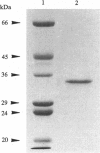Abstract
A specific requirement for coenzyme Q in the maintenance of trans-plasma-membrane redox activity is demonstrated. Extraction of coenzyme Q from membranes resulted in inhibition of NADH-ascorbate free radical reductase (trans electron transport), and addition of coenzyme Q10 restored the activity. NADH-cytochrome c oxidoreductase (cis electron transport) did not respond to the coenzyme Q status. Quinone analogs inhibited trans-plasma-membrane redox activity, and the inhibition was reversed by coenzyme Q. A 34-kDa coenzyme Q reductase (p34) has been purified from pig-liver plasma membranes. The isolated enzyme was sensitive to quinone-site inhibitors. p34 catalyzed the NADH-dependent reduction of coenzyme Q10 after reconstitution in phospholipid liposomes. When plasma membranes were supplemented with extra p34, NADH-ascorbate free radical reductase was activated but NADH-cytochrome c oxidoreductase was not. These results support the involvement of p34 as a source of electrons for the trans-plasma-membrane redox system oxidizing NADH and support coenzyme Q as an intermediate electron carrier between NADH and the external acceptor ascorbate free radical.
Full text
PDF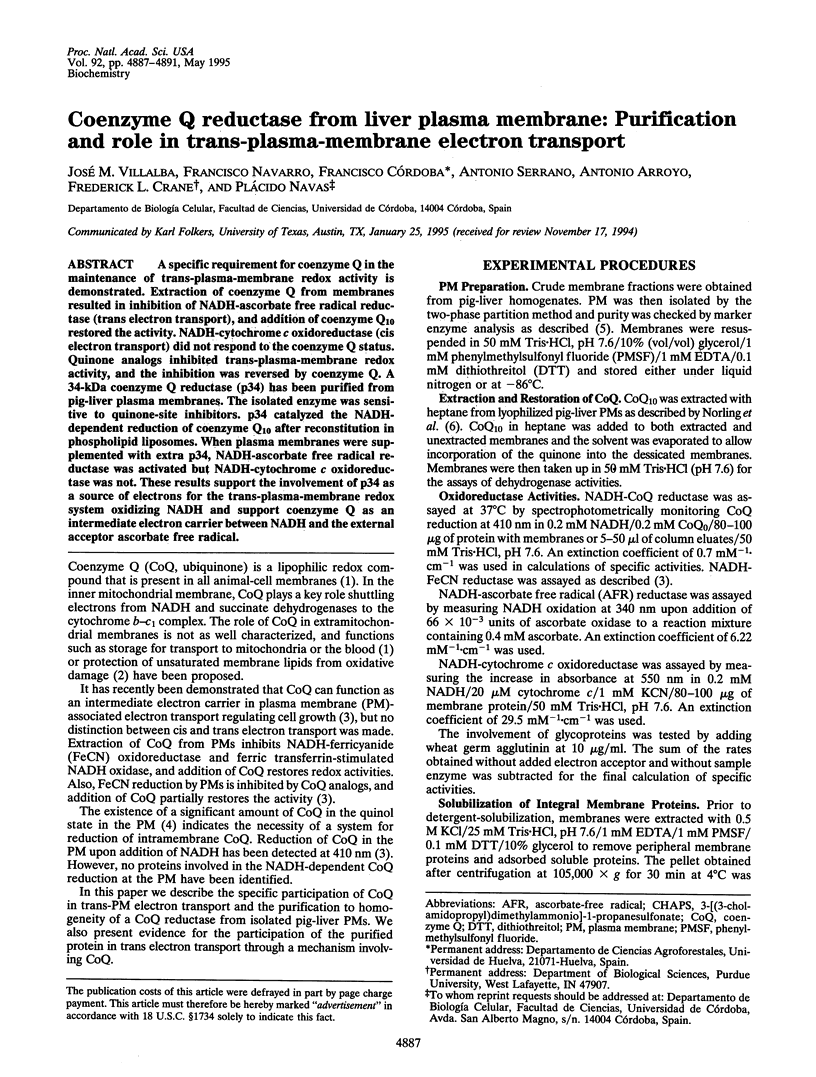
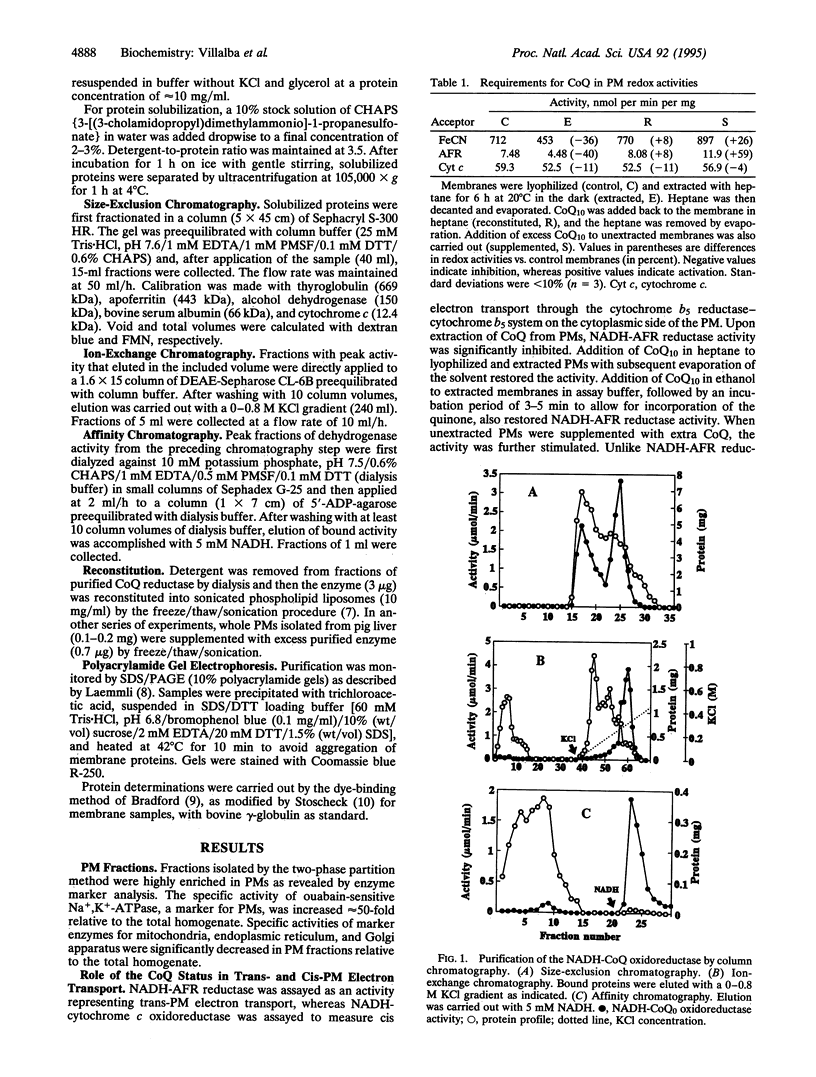
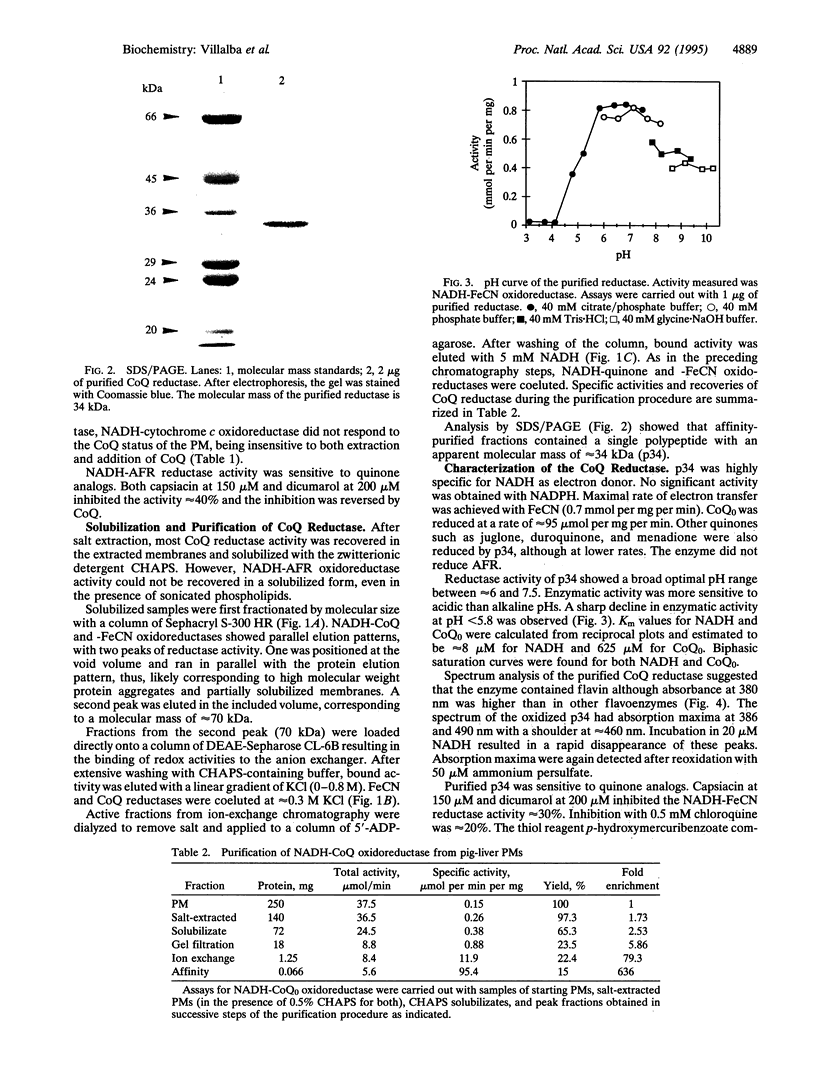
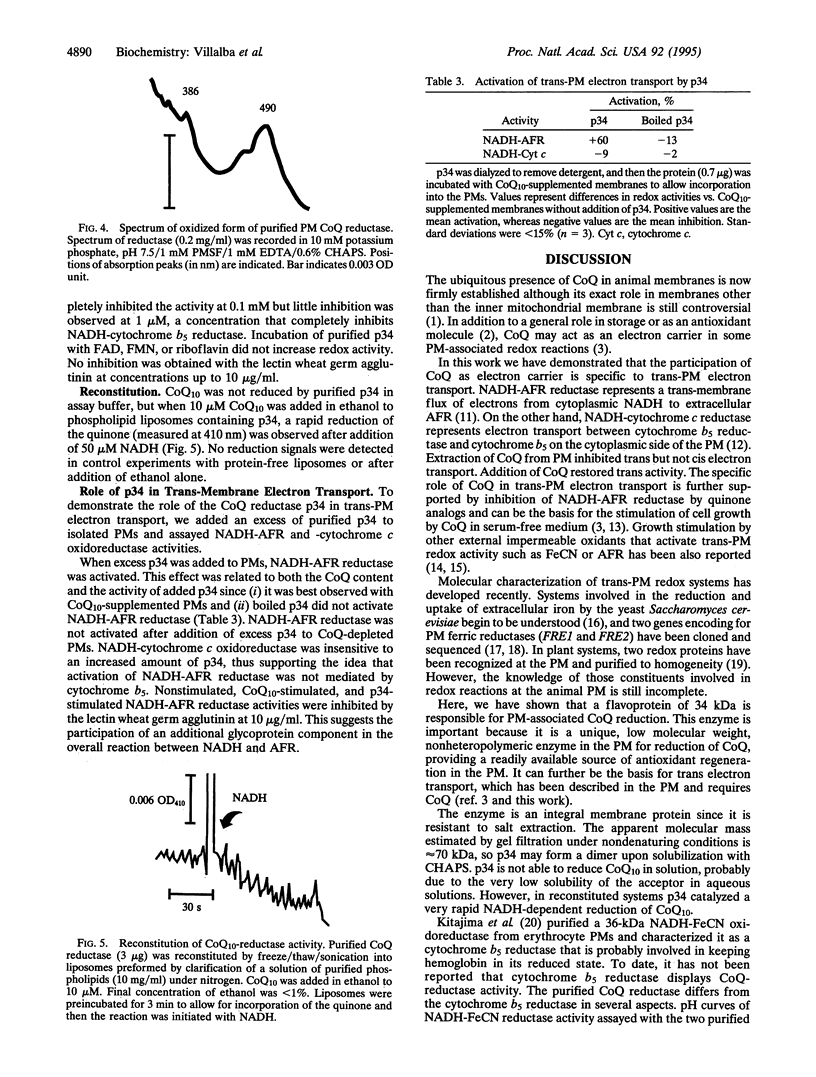
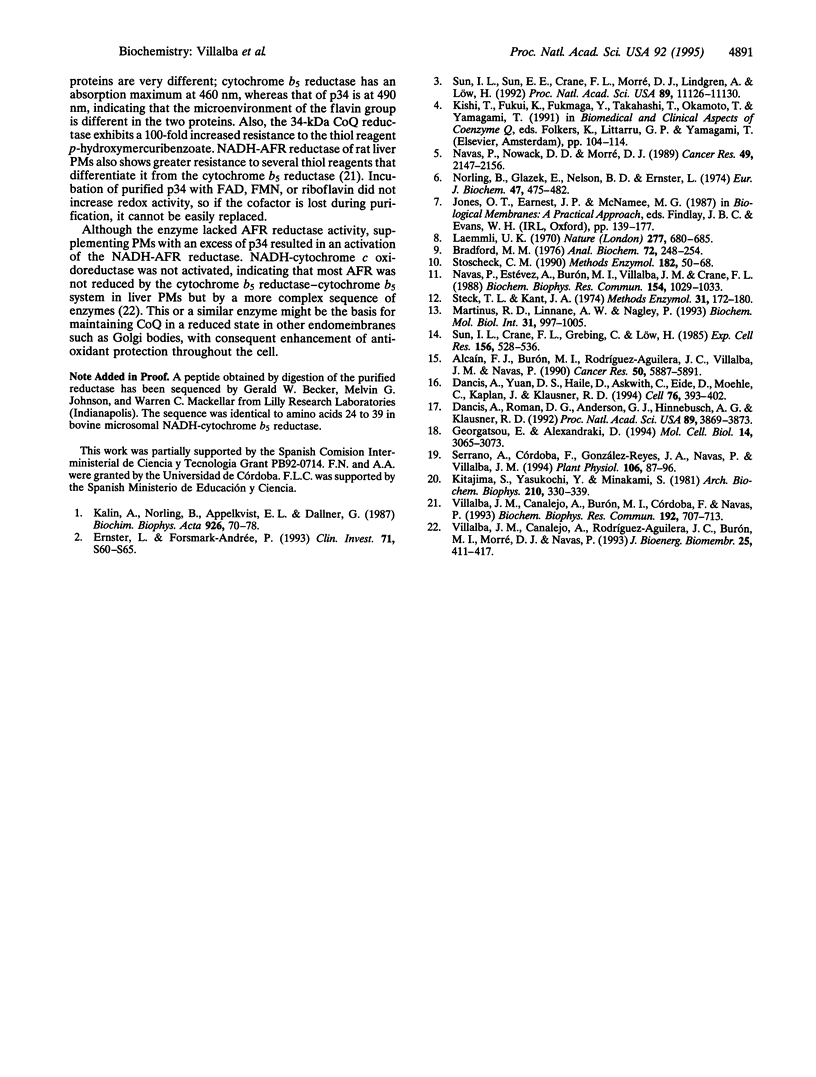
Images in this article
Selected References
These references are in PubMed. This may not be the complete list of references from this article.
- Alcaín F. J., Burón M. I., Rodríguez-Aguilera J. C., Villalba J. M., Navas P. Ascorbate free radical stimulates the growth of a human promyelocytic leukemia cell line. Cancer Res. 1990 Sep 15;50(18):5887–5891. [PubMed] [Google Scholar]
- Dancis A., Yuan D. S., Haile D., Askwith C., Eide D., Moehle C., Kaplan J., Klausner R. D. Molecular characterization of a copper transport protein in S. cerevisiae: an unexpected role for copper in iron transport. Cell. 1994 Jan 28;76(2):393–402. doi: 10.1016/0092-8674(94)90345-x. [DOI] [PubMed] [Google Scholar]
- Ernster L., Forsmark-Andrée P. Ubiquinol: an endogenous antioxidant in aerobic organisms. Clin Investig. 1993;71(8 Suppl):S60–S65. doi: 10.1007/BF00226842. [DOI] [PubMed] [Google Scholar]
- Georgatsou E., Alexandraki D. Two distinctly regulated genes are required for ferric reduction, the first step of iron uptake in Saccharomyces cerevisiae. Mol Cell Biol. 1994 May;14(5):3065–3073. doi: 10.1128/mcb.14.5.3065. [DOI] [PMC free article] [PubMed] [Google Scholar]
- Kalén A., Norling B., Appelkvist E. L., Dallner G. Ubiquinone biosynthesis by the microsomal fraction from rat liver. Biochim Biophys Acta. 1987 Oct 8;926(1):70–78. doi: 10.1016/0304-4165(87)90183-8. [DOI] [PubMed] [Google Scholar]
- Kitajima S., Yasukochi Y., Minakami S. Purification and properties of human erythrocyte membrane NADH-cytochrome b5 reductase. Arch Biochem Biophys. 1981 Aug;210(1):330–339. doi: 10.1016/0003-9861(81)90196-x. [DOI] [PubMed] [Google Scholar]
- Martinus R. D., Linnane A. W., Nagley P. Growth of rho 0 human Namalwa cells lacking oxidative phosphorylation can be sustained by redox compounds potassium ferricyanide or coenzyme Q10 putatively acting through the plasma membrane oxidase. Biochem Mol Biol Int. 1993 Dec;31(6):997–1005. [PubMed] [Google Scholar]
- Navas P., Estévez A., Burón M. I., Villalba J. M., Crane F. L. Cell surface glycoconjugates control the activity of the NADH-ascorbate free radical reductase of rat liver plasma membrane. Biochem Biophys Res Commun. 1988 Aug 15;154(3):1029–1033. doi: 10.1016/0006-291x(88)90243-4. [DOI] [PubMed] [Google Scholar]
- Navas P., Nowack D. D., Morré D. J. Isolation of purified plasma membranes from cultured cells and hepatomas by two-phase partition and preparative free-flow electrophoresis. Cancer Res. 1989 Apr 15;49(8):2147–2156. [PubMed] [Google Scholar]
- Norling B., Glazek E., Nelson B. D., Ernster L. Studies with ubiquinone-depleted submitochondrial particles. Quantitative incorporation of small amounts of ubiquinone and its effects on the NADH and succinate oxidase activities. Eur J Biochem. 1974 Sep 16;47(3):475–482. doi: 10.1111/j.1432-1033.1974.tb03715.x. [DOI] [PubMed] [Google Scholar]
- Serrano A., Cordoba F., Gonzalez-Reyes J. A., Navas P., Villalba J. M. Purification and Characterization of Two Distinct NAD(P)H Dehydrogenases from Onion (Allium cepa L.) Root Plasma Membrane. Plant Physiol. 1994 Sep;106(1):87–96. doi: 10.1104/pp.106.1.87. [DOI] [PMC free article] [PubMed] [Google Scholar]
- Sun I. L., Crane F. L., Grebing C., Löw H. Transmembrane redox in control of cell growth. Stimulation of HeLa cell growth by ferricyanide and insulin. Exp Cell Res. 1985 Feb;156(2):528–536. doi: 10.1016/0014-4827(85)90559-2. [DOI] [PubMed] [Google Scholar]
- Sun I. L., Sun E. E., Crane F. L., Morré D. J., Lindgren A., Löw H. Requirement for coenzyme Q in plasma membrane electron transport. Proc Natl Acad Sci U S A. 1992 Dec 1;89(23):11126–11130. doi: 10.1073/pnas.89.23.11126. [DOI] [PMC free article] [PubMed] [Google Scholar]
- Villalba J. M., Canalejo A., Burón M. I., Córdoba F., Navas P. Thiol groups are involved in NADH-ascorbate free radical reductase activity of rat liver plasma membrane. Biochem Biophys Res Commun. 1993 Apr 30;192(2):707–713. doi: 10.1006/bbrc.1993.1472. [DOI] [PubMed] [Google Scholar]
- Villalba J. M., Canalejo A., Rodríguez-Aguilera J. C., Burón M. I., Mooré D. J., Navas P. NADH-ascorbate free radical and -ferricyanide reductase activities represent different levels of plasma membrane electron transport. J Bioenerg Biomembr. 1993 Aug;25(4):411–417. doi: 10.1007/BF00762467. [DOI] [PubMed] [Google Scholar]



